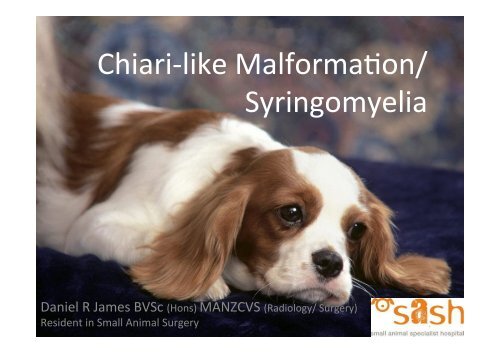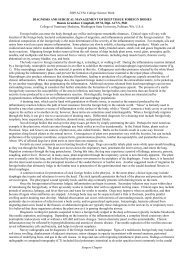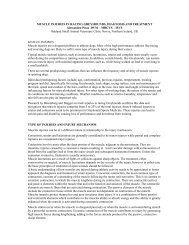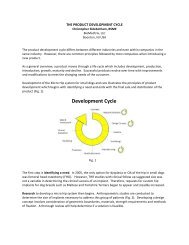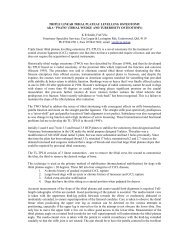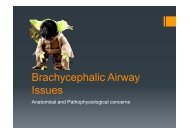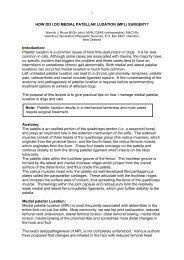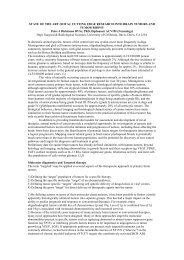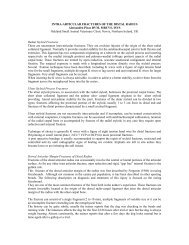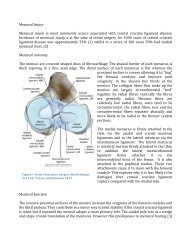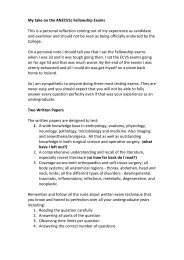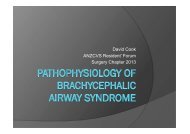Syringomyelia
Syringomyelia
Syringomyelia
Create successful ePaper yourself
Turn your PDF publications into a flip-book with our unique Google optimized e-Paper software.
Chiari-‐like Malforma/on/ <br />
<strong>Syringomyelia</strong> <br />
Daniel R James BVSc (Hons) MANZCVS (Radiology/ Surgery) <br />
Resident in Small Animal Surgery
<strong>Syringomyelia</strong> <br />
• Defini/ons-‐Syringo V hydro <br />
» Ependymal lining <br />
» Communica/ng <br />
» No Arnold <br />
» Chiari-‐LIKE
Clinical signs: <br />
• Usually recognized between 6m and 3yr old <br />
• Owners reported increased signs during <br />
exer/on, barking, or when excited. <br />
– thought that rapid changes in intrathoracic or <br />
intra-‐abdominal pressure are important
Clinical signs: <br />
• Characteris/c scratching at neck, <br />
shoulder, flank, ear or sternum. <br />
-‐ especially when walking <br />
-‐Typically unilateral <br />
-‐ “Phantom” scratching or “Air <br />
Guitar”
Clinical signs: <br />
• Scratching neck, shoulder, flank, ear or sternum. <br />
• Neuropathic pain <br />
-‐Spinal pain, especially neck pain. <br />
-‐may be episodic and o\en severe. <br />
-‐May be worse when head is lowered <br />
-‐Head ache*, radicular pain, allodynia <br />
dysaesthesia, Burning, pins & needles <br />
-‐
Expansion of syrinx <br />
Decussating fibres of the spinothalamic tracts affected firstparasthesia<br />
of associate dermatome<br />
Dorsal horn is plastic
Clinical signs: <br />
• Scratching neck, shoulder, flank, ear or sternum. <br />
• Neuropathic pain <br />
• Forelimb weakness, hindlimb ataxia <br />
-‐Expansion of syrinx into ventral <br />
columns, white maaer
Clinical signs: <br />
• Scratching neck, shoulder, flank, ear or sternum. <br />
• Neuropathic pain <br />
• Forelimb weakness, hindlimb ataxia <br />
• Scoliosis; may be seen as head /lt
Scoliosis <br />
• Relationship between<br />
cervical scoliosis and syrinx<br />
width<br />
• Probably not due to loss of<br />
muscle innervation<br />
• Appears to be associated<br />
with loss of afferent<br />
information from the cervical<br />
neuromuscular spindles
Clinical signs: <br />
• Scratching neck, shoulder, flank, ear or sternum. <br />
• Neuropathic pain <br />
• Forelimb weakness, hindlimb ataxia <br />
• Scoliosis <br />
• Signs due to SM or CM
Is all pain associated with <br />
syringomyelia <br />
Overcrowding of the foramen magnum may cause pressure on brainstem nuclei<br />
causing signs of pain. 9/48 clinical dogs in one study CM only<br />
November 17, 2012 | Veterinary Record
Clinical signs: <br />
• Scratching neck, shoulder, flank, ear or sternum. <br />
• Neuropathic pain <br />
• Forelimb weakness, hindlimb ataxia <br />
• Scoliosis <br />
• Asymptoma)c <br />
-‐ 60% CKCS breeding stock <br />
have a syrinx and no signs!
Clinical signs not due to SM <br />
• CKCS have lots of problems…. <br />
-‐Seizures. unrelated to CM/ SM, hydrocephalus* <br />
-‐Idiopathic facial palsy is common in the CKCS <br />
-‐so is hearing impairment <br />
*The Veterinary Journal 195 (2013) 235–237
What is Chiari-‐like Malforma/on <br />
• “Occipital hypoplasia” <br />
• Analogous to Chiari I malforma/on <br />
of humans <br />
Miller’s anatomy of the dog
What is Chiari-‐like Malforma/on <br />
• Occipital hypoplasia: Caudal Fossa too small for cerebellum <br />
• -‐Reduced volume of the caudal fossa <br />
• A reduced volume of the occipital bone was not found in Cavalier King Charles <br />
spaniels in general in comparison to French bulldogs <br />
• or Cavalier King Charles spaniels with syringomyelia compared to Cavalier King <br />
Charles spaniels without syringomyelia <br />
Vet Radiol Ultrasound, Vol. 53, No. 5, 2012, pp 540–544
What is Chiari-‐like Malforma/on <br />
• Occipital hypoplasia: Caudal Fossa too small for cerebellum <br />
• -‐Reduced volume of the caudal fossa <br />
• Increased hindbrain volume in CKCS causes the tentorium cerebelli to <br />
compensate by bulging in a rostral direc/on <br />
• “pars caudalis” rela/vely insensi/ve to increase cerebellar size. <br />
T. A. Shaw Veterinary Record (2013)
What is Chiari-‐like Malforma/on <br />
• Occipital hypoplasia: Caudal Fossa too small for cerebellum <br />
• CKCS has a rela/vely larger cerebellum <br />
than small breed dogs and Labradors <br />
• Also larger in young CKCS with CM and SM <br />
than in older CKCS with CM alone <br />
Thomas A. Shaw <br />
PLoS One. 2012; 7(4): e33660.
Indenta/on of cerebellum (CKCS) <br />
Upward “kink” at cervicomedullary junc/on
Chiari-‐like Malforma/on <br />
• Hernia/on of the cerebellar vermis <br />
• “Gap” Between cerebellum and brain stem
Shortened <br />
Basicranium
Pathogenesis of CM> SM <br />
-‐Theories only
Systolic CSF pulses <br />
Miller’s Anatomy
Waterhammer <br />
Effect <br />
• CSF forced down the central canal from the <br />
fourth ventricle due to increased intrathoracic <br />
or abdominal pressure <br />
• Relies on a communica/on between the <br />
fourth ventricle and the central canal <br />
• Would expect to also result in hydrocephalus
Piston Theory <br />
• Displaced cerebellar tonsils act like a piston <br />
and with each systole are forced caudally <br />
• Pressure wave within the entrapped <br />
subarachnoid space and syrinx <br />
• Also relies on CSF being forced into the spinal <br />
cord from the subarachnoid space. <br />
• Would seem more likely to be crushed than <br />
expand with a syrinx
Suck effect <br />
• Based on inability of pressure to equilibrate <br />
due to foramen magnum obstruc/on <br />
• Similarly reliant on fourth ventricle <br />
communica/on <br />
• Implies low syrinx pressure
Slosh Effect <br />
• Pressure differences can cause a surge of fluid <br />
within the syrinx, resul/ng in further fissuring <br />
and damage to the spinal cord <br />
• This is thought to be important for the <br />
con/nued development of a syrinx
BUT: <br />
• Fluid thought to be of extracellular origin not <br />
CSF. <br />
• Syringomyeilia o\en start non-communica/ng<br />
<br />
• Chiari dogs o\en have hyperintensity on T2 <br />
dorsal to central canal before development of <br />
syrinx
Intramedullary <br />
Pulse Pressure Theory <br />
• Holds true regardless of ae/ology <br />
• Transmission and reflec/on of the systolic CSF <br />
pulse pressure into spinal cord /ssue <br />
• Low pressure in sub-‐arachnoid space due to <br />
pulse velocity and turbulence. <br />
• This repeated mechanical distension of the <br />
cord results in dilata/on of the central canal <br />
and accumula/on of extracellular fluid which <br />
eventually coalesces into cavi/es
• Venturi effect <br />
Bernoulli's principle
CEREBROSPINAL FLUID FLOW <br />
• CSF flow velocity assessed using phase-contrast<br />
cine MRI at the foramen magnum <br />
• Velocity in the dorsal aspect of the <br />
subarachnoid space at the foramen magnum <br />
significantly lower in CKCS <br />
• Turbulent flow and jets were associated with <br />
syringomyelia presence and severity <br />
CERDA-‐GONZALEZ. Veterinary Radiology & Ultrasound, Vol. 50, No. 5, 2009
Other causes of CSF flow <br />
obstruc/on causing SM
What causes SM when <br />
CM not present
SM <br />
without <br />
CM <br />
CM <br />
Without <br />
SM
Is <br />
‘Gap’ size <br />
more <br />
useful
Volume reduc/on of the <br />
jugular foramina <br />
• CKCSs without SM presented <br />
significantly larger JF volumes when <br />
compared with CKCSs with SM <br />
• Link between brachycephaly and abnormal <br />
CSF flow can be found in the skull base <br />
• May explain the ae/ology of CSF pressure <br />
waves in the subarachnoid space, <br />
independent of cerebellar hernia/on <br />
Schmidt et al. BMC Veterinary Research 2012, 8:158
Diagnosis <br />
• Ultrasonography has a low sensi/vity for <br />
diagnosis of Chiari-‐like malforma/on/ <br />
syringomyelia. <br />
• Rads may reveal a short caudal fossa–<br />
subjec/ve. Myelography risky <br />
• CT most effec/ve way of defining boney <br />
structures of CM <br />
• Only definite way to diagnose syringomyelia is <br />
by MRI. Posi/oning <br />
Journal of small Animal Prac/ce (2008) 49, 438–443 Vet Radiol Ultrasound, Vol. 53, No. 5, 2012, Vol. 49, No. 5, 2008
Differen)al Diagnosis-‐Pain <br />
• IVDD <br />
• GME <br />
• AA luxa/on <br />
• Neoplasia <br />
• Trauma <br />
• Discospondyli/s <br />
• Bacterial meningi/s
Differen)al Diagnosis-‐ Scratching <br />
• Ear disease-‐ PSOM <br />
• Skin disease <br />
• Head-‐Foot irrita/on syndrome
Factors associated with the presence <br />
of neurologic signs <br />
• <strong>Syringomyelia</strong>, degree propor/onate to size <br />
• Ra/o of caudal fossa/total cranial cavity <br />
volume was significantly smaller in clinically <br />
affected Cavalier King Charles Spaniels <br />
Veterinary Radiology & Ultrasound, Vol. 50, No. 1, 2009
Prevalence: <br />
• Most CKCS affected by CM <br />
-‐87.5% asymptoma/c had occipital hypoplasia based on <br />
subjec/ve criteria of crowding <br />
• Many ‘normal’ dogs have syringomyelia <br />
-‐27% compared with 88% dogs with neurologic signs <br />
-‐ 60% in Sydney’s responsible breeding popula/on <br />
Veterinary Radiology & Ultrasound, Vol. 50, No. 1, 2009,
Medical treatment <br />
• Typically does not resolve, the clinical signs. <br />
• NSAIDs for mild pain <br />
• Pred effec/ve. Dose> adverse side effects <br />
• Gabapen/n / Pregabalin <br />
• Oral opioids <br />
• Frusemide <br />
• Omeprazole, tricylic an/depressants
Long-‐term outcome <br />
• Clinical signs sugges)ve of Neuropathic Pain <br />
progress in three-‐quarters <br />
• 75 per cent s/ll alive 39 (±14.3) months later, <br />
with an acceptable QOL <br />
November 17, 2012 | Veterinary Record
Surgical Treatment <br />
• People with Chiari I receive foramen magnum <br />
decompression <br />
• Success controlling symptoms in humans is <br />
high <br />
• High rate of re-‐opera/on, mostly due to scar <br />
/ssue causing recurrent stenosis
Foramen magnum <br />
decompression <br />
• Based on premise of CM being homologous to <br />
Chiari I of humans and COMS being sole cause <br />
• Minimal intra-‐opera/ve complica/ons <br />
• 1/16 dog died, and 1 euthana/zed. <br />
• Signs resolved in 7/16 dogs <br />
• Improved in 6/16 dogs, and <br />
• Remained unchanged in 1 dog. <br />
Dewey. JAVMA, Vol 227, No. 8, October 15, 2005
Follow up MRIs-‐ Scar /ssue <br />
• 1 dog unchanged post Foramen magnum <br />
decompression <br />
• 3 dogs deteriorated a\er ini/al improvement <br />
– 2/3 improved following second surgery, 1 died <br />
• Marsupializa/on 5 dogs-‐ no further Sx
Foramen magnum <br />
decompression <br />
• All dogs made a quick recovery a\er surgery <br />
and were exercising normally within 4 weeks <br />
• No dogs had complete resolu/on of signs <br />
• 12/15 improved <br />
• 47% subsequently deteriorated 0.2 – 2.3 years <br />
• Gross inspec/on revealed <br />
layers of scar /ssue in 2 <br />
C. Rusbridge– Veterinary Surgery
• Dura/on of clinical signs prior to surgery was <br />
strongly correlated with outcome. <br />
• Shape/ size of the syrinx unchanged
Treatment <br />
• Results—No intraopera/ve <br />
complica/ons <br />
• Worsening of a pre-‐exis/ng head /lt and ataxia in <br />
1/21 dogs <br />
• Seventeen (81%) had clinical improvement <br />
• 25% required re-‐opera/on <br />
• 2 dogs were euthana/zed <br />
• Follow-‐up 11.2 months (3.5–21 <br />
• Vs 16m <br />
DEWEY et al Veterinary Surgery 36:406–415, 2007
Treatment-‐ <br />
Syringosubarachnoid <br />
shunt <br />
• No intra-‐ or peri-‐opera/ve <br />
complica/ons <br />
• Progressive neurological <br />
improvement in 9/11 dogs 2 <br />
weeks and 6 months <br />
postopera/vely <br />
• 7 contacted long term and no <br />
deteriora/on <br />
• Resolu/on of Syrinx 1/3 <br />
Journal of Small Animal <br />
PracBce (2012) 53, 205–212
Where to for CKCS <br />
• Complex mode of inheritance <br />
• Already /ny gene pool with mul/ple other <br />
disease concerns <br />
• DNA collec/on <br />
program is underway
Acknowledgments <br />
• Clare Rusbridge <br />
• BVMS PhD DipECVN
Acknowledgments <br />
Georgina Child <br />
BVSc Diplomate ACVIM (Neurology)


